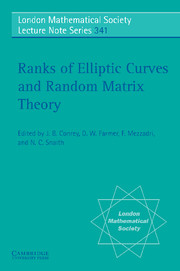Book contents
- Frontmatter
- Contents
- Introduction
- FAMILIES
- RANKS OF QUADRATIC TWISTS
- NUMBER FIELDS AND HIGHER TWISTS
- SHIMURA CORRESPONDENCE, AND TWISTS
- GLOBAL STRUCTURE: SHA AND DESCENT
- Heuristics on class groups and on Tate-Shafarevich groups
- A Note on the 2-Part of Ш for the Congruent Number Curves
- 2-Descent Through the Ages
- Index
Heuristics on class groups and on Tate-Shafarevich groups
Published online by Cambridge University Press: 10 November 2010
- Frontmatter
- Contents
- Introduction
- FAMILIES
- RANKS OF QUADRATIC TWISTS
- NUMBER FIELDS AND HIGHER TWISTS
- SHIMURA CORRESPONDENCE, AND TWISTS
- GLOBAL STRUCTURE: SHA AND DESCENT
- Heuristics on class groups and on Tate-Shafarevich groups
- A Note on the 2-Part of Ш for the Congruent Number Curves
- 2-Descent Through the Ages
- Index
Summary
When we have to study a number field or an elliptic curve defined over ℚ, some groups may appear which make the explicit computations more complicated and which are, in a way, not very “welcome”. These groups are the class groups of number fields and the Tate-Shafarevich groups of elliptic curves. A direct study of their general behavior is a very difficult problem. In, Cohen and Lenstra explained how to obtain precise conjectures for this purpose using a general fundamental heuristic principle. In, it is shown how to adapt the Cohen-Lenstra idea to Tate-Shafarevich groups using the analogy between number fields and elliptic curves. Understanding the behavior of Tate-Shafarevich groups is important in itself first but it may also be useful for studying the distribution of the special values of the L-functions L(E, s) attached to elliptic curves. Indeed, the Birch and Swinnerton-Dyer conjecture relates the value L(E; 1) to natural invariants of E including the order of the Tate-Shafarevich group. This paper sketches the Cohen-Lenstra philosophy in both cases of class groups and of Tate-Shafarevich groups. It is organized as follows:
In the first section, we describe the analogy between number fields and elliptic curves defined over ℚ. In the second section, we recall the Cohen-Lenstra heuristic for class groups. Using the analogy of the first section, we adapt, in the third section, the heuristic for Tate-Shafarevich groups. Finally, we restrict the heuristic to the case of families of quadratic twists of an elliptic curve. Acknowledgements.
- Type
- Chapter
- Information
- Ranks of Elliptic Curves and Random Matrix Theory , pp. 323 - 340Publisher: Cambridge University PressPrint publication year: 2007
- 19
- Cited by

